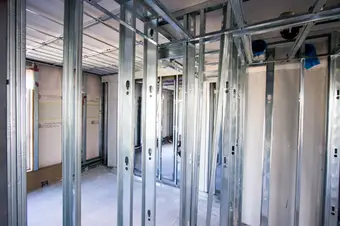Think an 18-story residence building made of wood sounds like a bad idea in a rainy, earthquake-prone city like Vancouver? Well, you’d be right, so it’s a good thing that UBC’s new Tall Wood Building — Brock Commons — isn’t actually a wooden building.
Wait, what?
“Technically we would refer to Brock Commons as a hybrid, mass timber structure,” said Perry Adebar, UBC's civil engineering department head and an expert in high-rise, concrete buildings like the ones that make up most of Vancouver’s skyline.
Brock Commons, which is advertised as the world’s tallest wood building (it isn’t) is a mix of a lot of different materials like most high-rises today. The new residence hall has a concrete foundation and two concrete cores. It has glass windows, steel connectors and a wood fibre, high-pressure laminate (which isn’t really wood). So where does the wood come in?
“The mass timber structure forms the floor plates and the structural columns,” said John Metras, the managing director of Infrastructure Development at UBC.
The wood used in Brock Commons, referred to as mass timber, is as high-tech as wood can get. The floors of the building are made up from cross laminated timber (CLT). To make a CLT panel, you take a giant lumber board and cover it in adhesive, and then take a second giant lumber board, turn it 90 degrees so that its grain is perpendicular to the first board and gluing it on top — like a glued together Jenga tower. Then do it again and again and again until you have three to seven layers (Brock uses five-layered CLTs). Then coat the whole thing in some chemicals and you’ve got yourself something that can be as strong as concrete — at least in some ways.
Because wood is only strong in the direction of its grain, by turning the boards 90 degrees, CLTs are strong in two directions instead of one.
Brock Commons also has wooden columns made out of a second mass timber technology called glulam. Similarly to CLTs, glulam takes lumber, glues it together with moisture-resistant adhesives, except in glulam, all the wood has the grain going the same way, giving it strength in one dimension lengthwise.
The CLTs are stacked between glulam pillars and connected by steel connectors to form the floors and vertical support for Brock Commons. However, the wood needs help to make the building strong enough to stand 18-storeys high.
[Sorry, video not found. You can contact webmaster@ubyssey.ca to fix the issue]
“In simple terms, you can break a high-rise building into two parts. There is the portion that resists all the lateral forces — we call it the ‘lateral force resisting system,’” said Adebar. “We call the rest of it a ‘gravity frame’ — the floors and the columns and all that. You need something to take the vertical load — all this needs to do is to resist [gravity].”
To stop the building from tipping over, Brock Commons has two giant concrete towers. To prevent the building from collapsing under its own weight, Brock has wood floors and columns connected by steel connectors.
When Adebar and other structural engineers look at Brock Commons, they don’t see a building that’s much different from a skyscraper in Toronto or Vancouver — at least when it comes to earthquakes or wind.
“The timber portion of the structure doesn’t do anything to resist wind loads or earthquake loads,” said Adebar. So vertically, Brock Commons is just a plain old reinforced concrete building, but plain old reinforced concrete is really good at stopping buildings from falling over because of wind of earthquakes.
“Wood structures actually perform quite well in a seismic event because they are relatively light. There isn’t a lot of mass or inertia that is generated during a seismic event. That’s a benefit of a wood structure,” said Metras.
All wood does horizontally, explained Adebar, is change the calculations because it’s so much lighter than concrete or steel.
It’s in resisting gravity — in the vertical direction — that the building is primarily wood. Buildings are heavy and need to support their own weight, plus the weight of all the showers, toilets, people and beds on each floor. All together, those forces make up the gravity load.
“We have steel connectors that connect the columns at each floor level, and they allow for the loads to be transferred straight down the building through the columns and not produce any stress on the wood floor plates,” explained Metras.
The weight of the eighteenth floor goes through the steel connectors down the wood column between floors 17 and 18. Then, at the seventeenth floor, the weight passes through another steel connector to the next column — the one between the sixteenth and seventeenth floors. This happens all the way down the building until the weight hits the concrete foundation, where the concrete and the ground support the building’s weight.
“It’s a beautiful use of different materials,” said Adebar.
The steel joints that connect the wooden columns to the floors play an important role in the vertical support of the building. They allow the weight of the building to be transported straight down the building instead of spreading the weight over each floor. This takes strain off the floors and makes sure all the weight is taken down to the concrete foundation.
The building also has built in sensors to monitor its function over time. The sensors will measure moisture and how much the building moves and deforms.
First online
Share this article








